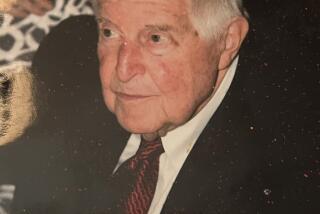Peter Berg dies at 73; advocate for bioregionalism
When thousands of American youths dropped out of mainstream society and descended on San Francisco in the mid-1960s convulsion known as the counterculture, Peter Berg and a small band of like-minded subversives were there to greet them.
Calling themselves the Diggers, they dished out free food in Golden Gate Park, opened a free store in Haight-Ashbury and staged free street performances — guerrilla theater, as Berg named the impromptu events. Through such provocative actions the Diggers sought to create a sense of community in the middle of a cultural maelstrom.
Several years later, Berg found another consuming passion, but the idea at its root was the same: to foster a radically new way of living.
Berg became the champion of an environmental movement called bioregionalism, which stresses identification with one’s community, awareness of its natural resources and commitment to restoring them.
The founder of the San Francisco-based Planet Drum Foundation, a grass-roots clearinghouse for hundreds of bioregional groups in the United States and abroad, Berg, 73, died July 28 in San Francisco. He had lung cancer and pneumonia, said Judy Goldhaft, his life partner.
Berg defined a bioregion as a geographical area with a distinct ecosystem and usually a common watershed. He regarded bioregionalism as a way to reorganize society because humans are centrally important to sustaining the region they live in.
Gary Snyder, the Pulitzer Prize-winning poet and environmental thinker, said Berg’s efforts were of “immeasurable importance in defining and disseminating the ideas and possibilities of bioregionalism.” He credited Berg with formulating ideas that were decades ahead of their time.
“He was a genius in the sense that many pioneers are,” said Paul Krassner, the counterculture writer and co-founder of the Yippies, who knew Berg for more than 40 years. “In 1966 he used the word ‘ecology,’ which I had never heard before. I had to look it up in the dictionary.”
Berg was born Oct. 1, 1937, in Long Island, N.Y., but grew up in Florida, where his mother moved after breaking up with his alcoholic father. He belonged to a juvenile gang as well as the Latin Club at school, where he was a top student. At 16, he won a scholarship to the University of Florida and majored in psychology.
At 17 he dropped out and hitchhiked across the country to mingle with the elites of the Beat movement in San Francisco. After completing a stint in the Army, he moved to New York, participated in civil rights protests and acted in a play.
In 1964 he returned to California and joined the San Francisco Mime Troupe as a writer, director and performer. The troupe wanted to perform in Golden Gate Park without a permit, which attracted a large crowd of what Berg described as “alternative culture people”— young men in beards and beads and young women in short skirts and flowing hair.
Troupe director R.G. Davis opened the show by announcing, “Ladies and gentlemen, we are presenting an arrest.” The police swooped in. Berg dubbed the performance guerrilla theater, a term Davis later popularized in a series of magazine and journal articles.
In 1966, Berg and actor Peter Coyote were among the troupe members who formed the Diggers, named for a group of 17th century English revolutionaries who fed the poor by digging up common land and cultivating it. The latter-day Diggers turned surplus food into free “Digger stew,” distributed other people’s castoffs in a Free Store and gave free performances, some whimsical, others not.
In one piece, written by Berg, a military policeman paraded his prisoners onto Berkeley’s Sproul Plaza and proceeded to mistreat them. The brutal display was so convincing that, Berg recalled in the book “Sixties Radicals, Then and Now” by Ron Chepesiuk, “an ROTC officer in the audience … actually congratulated the MP for the way he was handling his men.” Other bystanders were appalled.
In 1969, the Diggers disbanded and Berg, Goldhaft and their daughter, Ocean, took off in a caravan across the country. During the trip he observed a number of environmental problems, including radioactive waste dumps in New Mexico and widespread deforestation in the Ozarks. “More and more it occurred to me that the most important question to consider was the position of human beings in natural systems,” he told oral historian Jeff Kisseloff in the book “Generation on Fire.”
In 1973 he launched the Planet Drum Foundation to teach others how to “reinhabit” and restore their natural environment through such means as supporting local food production and pollution-free energy systems.
He outlined his ideas in a number of books and essays, including “Reinhabiting California” (1976), co-written with pioneering ecologist Raymond Dasmann.
Many of his ideas remained too radical for the mainstream. Believing, for example, that the bioregion is a better way to divide the planet than cities, states and nations, Berg always added “Shasta Bioregion” to his address.
About 25 years ago, he decided to tear up the sidewalk outside his office and replace it with greenery. He wanted the seeds from the vegetation to “blow down the street and crack open all the sidewalk with native plants.”
Now the sidewalk garden of manzanitas, blue-eyed grass and toyon shrubs stretches 90 feet long — “probably the longest native plant garden in the state,” said Goldhaft, who survives him along with their daughter, a stepson, two granddaughters and a sister.
More to Read
Start your day right
Sign up for Essential California for the L.A. Times biggest news, features and recommendations in your inbox six days a week.
You may occasionally receive promotional content from the Los Angeles Times.







